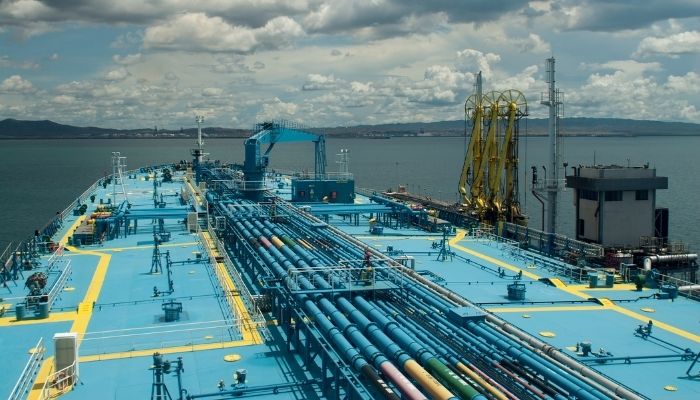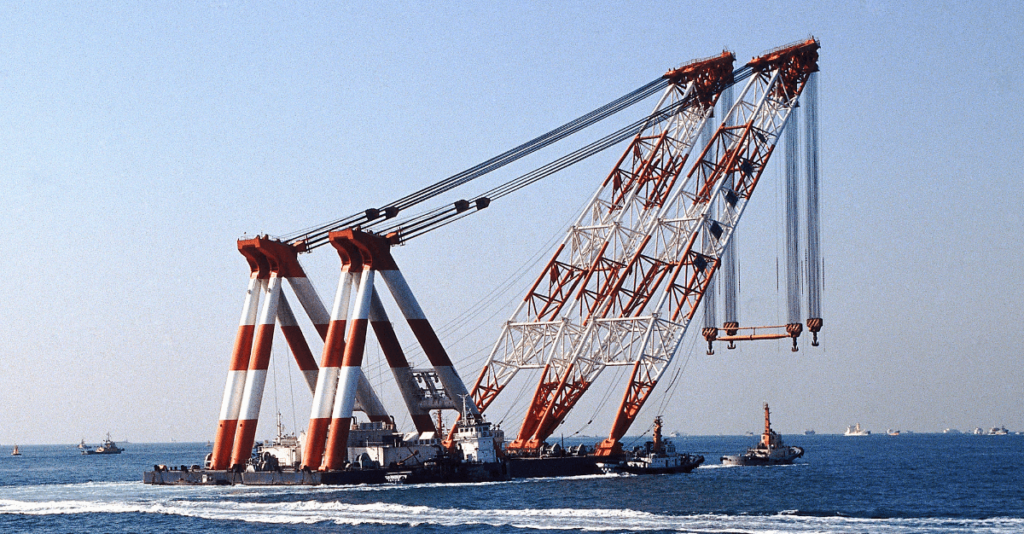What is a Mast Riser?
Natural resource derivatives like petroleum-based products are crucial for the world economy. These invaluable products include crude oil, or in other words, naturally extracted liquid compounds from which various kinds of petroleum products are derived or the derivatives themselves, like refined oils or gases. Specially designed oil tankers and LNG carriers transport these crucial products across the globe.
However, appropriate care must be taken to avoid accidents as these products are highly flammable, which means they tend to catch fire with the slightest trigger. It essentially means that with the interference of any causal factors near its vicinity, it can burst into raving flames in no time.
Speaking of these factors, a spark or fire is the main reason for these disasters. Remember seeing those large ‘No smoking’ boards in hazardous places like petrol pumps or gas stations?
While smoking is also prohibited onboard ships, especially in the enclosed spaces within the hull, there can still be other means for catching fire. They include accidental gaseous leakages, overheating of any machinery or systems, electrical sparks or short circuits, and so on.
However, while these aspects are considered for quality control, it can still be said that to err is human. So, it cannot be asserted with 100% certainty that everything will be perfect and ideal throughout a vessel’s service life, and there can never be emergencies or disasters.
But from the point of view of risks and hazards, we can always strive for two things: even in the doomed instance of something unwanted, we can still put in the best efforts to reduce the severity or impact of the aftermath or upshot.
Moreover, give in our sincere efforts to at least reduce the chances or the probability of something unwarranted happening. Once again, by the laws of nature, no likelihood of occurrence or non-occurrence, in this case, can be zero but yes, even trying our best to keep the value of this probability as low as possible is itself a positive trait. Hence, for the prevention of fire, this needs to be kept in mind.
All classification rules and regulations and statutory guidelines for all vessels have a special designation for fire hazards. You may have read about the Fire Safety Protection Plan for prevention or at least mitigation of fire and the Escape Plan for safe evacuation and escape of crew or passengers in a fire emergency. Now, for tankers, it is evident that the concern for fire prevention and mitigation is very high, given the cargo they carry.
While crude oil carriers or tankers have a significantly high degree of safety considerations, tankers carrying refined products like natural gases or petroleum derivates have an extremely high degree of safety rules as they are even much more flammable than crude or unprocessed products.
While we shall discuss some of these safety measures in our future publications, for now, let us discuss an essential feature of oil tankers, the mast risers.
What is a mast riser?
Now, looking at the nomenclature, please do not get confused! This has nothing to do with mast, which is also very much a marine term, and alludes to those vertical erections over the main deck, which have been those supports for sails in older ships to various tower-like installations for telecommunication or other purposes in modern vessels.
A mast riser is essentially a device or, rather, a system to relieve the pressure accumulated inside the cargo tanks of oil tankers. Now by pressure, we mean what? Most liquid substances, when entrapped or enclosed within a bound space, until and unless filling the entirety of the given space, emits a vapour that occupies the remaining volume within that space.
For example, if you have a half-filled bottle of soft drink, the rest of the bottle gets filled with vapours. That’s why you hear a fizzy sound every time you open a soft drinks bottle irrespective of the volume because even when it is full, there is always some negligible amount of space close to the cap or lid which gets filled with highly pressurised carbon vapours that tend to escape instantaneously when the bottle gets opened.
Now, while their chemistry may differ from that of soft drinks, even petroleum products tend to emanate vapours around them when enclosed. These keep on accumulating over time if not allowed to escape. The pressure builds as these vapours accumulate without being allowed to escape. This is the case in tankers holding petroleum products in enclosed tanks or holds.
Now, these crude oil vapours are equally inflammable as their original liquid form. Moreover, by the chemistry of inflammable substances, the combustibility is directly proportional to the pressure. Henceforth, as the pressure surmounts within the closed tank spaces, the risks associated with inflammability develop manifold.
The vapours not only become highly pressurised but also put pressure on the fluid medium it co-occupies. Now, as liquids are incompressible, it is once again a problem. Henceforth, there should be means to prevent this unwanted pressure from building in large amounts and allow the accumulated vapours to escape from time to time. This is precisely the role of a mast riser.
Design and Construction of a Mast Riser
The mast riser is nothing but a valve and comes under the category of cargo tank venting systems. In appearance, it resembles a pipe-like installation that originates above the tanks or spaces and projects above the main deck level.
It is a ventilation or venting component. The exposed part or the portion of the riser that projects above the main deck plate is 6 metres for all practical purposes. The inlet is on the inside of the cargo hold, and the outlet is on the outside.
Now, speaking of inlets, there may be various piping inside the cargo tank that is sometimes merged into a single common outlet which ends above the main or exposed deck. These pipes are venting systems that channel vapours accumulated inside the tanks or holds. Another intermediate valve is the isolation valve, which connects these venting lines and the mast riser.
There can also be other kinds of valves like bypass valves, pressure valves or vacuum valves that are fitted in conjunction with the mast riser. Often situated below the mast riser is the VOCON valve, which stands for Vapour Pressure Release Control Valve.
This essentially controls the closing pressure of the mast riser system based on requirement and operation. The pressure setting for this valve is done remotely. Another crucial feature of the mast riser is the presence of a flame arrestor at the outlet.
Now, the mast riser is not always used. It is only put into operation when the inside pressure of the tank or hold is high. However, the rest of the venting systems are always kept on that are routed to the mast riser. Now, beyond a specific limit of accumulated pressure, the riser is turned on, and the vapours are allowed to escape.
Now, the pressure relieving system is not only for fire prevention. Another essential purpose for keeping the mast riser and other venting systems in place is during loading the liquid cargo when any vapours remaining in the cargo holds need to be expelled beforehand.
This enables proper and seamless loading of cargo. Another system similar to the mast riser is the Vapour Emission Control System or VEPC. However, one major difference between the mast riser and VEPC is that while the former expels the assimilated gases into the atmosphere, the latter reverts them to the shore via pipeline networks. So, VEPC is only used during loading and unloading.
Most liquid cargo vessels like tankers have multiple mast risers based on the requirement, size of tanks, and the properties of the substance carried. The size of the risers and the material properties are as per regulations.
Most modern designs have automated control of the opening and closing of these risers. These need to be cleaned and maintained regularly to prevent the accumulation of soot, sludge or other forms of dirt. The mast riser outlets are generally watertight when closed to avoid water ingress during deck flooding or bad weather conditions like rain, snow, or thunderstorms.
You might also like to read-
- What is an Inert Gas or IG System on Ships?
- Understanding Stability of Submarine
- Safety Features on LNG Powered Ships
- Important Points for Committing Cargo Quantities in Tanker Ships
- 6 Benefits of Information Exchange in the Maritime Industry
Disclaimer: The authors’ views expressed in this article do not necessarily reflect the views of Marine Insight. Data and charts, if used, in the article have been sourced from available information and have not been authenticated by any statutory authority. The author and Marine Insight do not claim it to be accurate nor accept any responsibility for the same. The views constitute only the opinions and do not constitute any guidelines or recommendations on any course of action to be followed by the reader.
The article or images cannot be reproduced, copied, shared, or used in any form without the permission of the author and Marine Insight.
Latest Ship Safety Articles You Would Like:
Do you have info to share with us ? Suggest a correction
Subscribe To Our Newsletters
By subscribing, you agree to our Privacy Policy and may receive occasional deal communications; you can unsubscribe anytime.
Web Stories
Related Posts

About Author
Subhodeep is a Naval Architecture and Ocean Engineering graduate. Interested in the intricacies of marine structures and goal-based design aspects, he is dedicated to sharing and propagation of common technical knowledge within this sector, which, at this very moment, requires a turnabout to flourish back to its old glory.



























